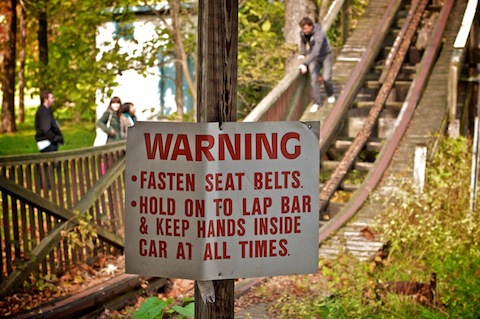
As we recently explored in our post about wildlife strikes, even the most advanced technology cannot withstand Mother Nature’s meddling. Roller coasters are another case in point, as explained in this rather fascinating bit by a veteran amusement-park techie:
A ride error is usually caused by an issue with the photo eye sensors…On Talon, the train has eight cars, so the photo eye needs to have its connection broken eight times so that the computer knows that all eight cars have traveled through the course. There are several photo eye sensors on the ride, including a set at each end of the station, a set on the lift, a set near the trim brake at the bottom of the Immelman loop, and then multiple sets on the brake run.
When a sensor is not broken eight times exactly, the computer senses that something is wrong. In the most drastic case, a car has become detached from the rest of the train. In this case, the sensor may only be broken seven times, so the sensor immediately relays the information to the computer that something is wrong and the ride must emergency stop, which is why sometime rides will stop on the brake runs, lift hills, or even halfway in or out of the station, because power is immediately cut off from the ride and all of the brakes close to avoid collisions.
This is a great insight as to how safe rides truly are, but that doesn’t explain why a ride error may occur when everything is running fine. In most cases, it is simply a bird, bug, or butterfly landing on the photo eye, causing it to be broken but not the correct number of times. The computer thinks something is wrong and shuts down the ride.
In other words, an insect the size of a thumbnail can cause a $13 million piece of hardware to screech to a halt. The more elaborate our systems, the greater their vulnerabilities to the tiniest of actors.
(Image via What’s His Face)


Captured Shadow // Dec 4, 2012 at 1:07 pm
Might be time to put some magnetic proximity sensors, or RFID tags in as back up.
Physicist // Dec 10, 2012 at 11:04 pm
Can’t say I know much about this, but are there seriously no wavelengths they could use to which a butterfly is transparent but a metal rollercoarster car isn’t? Or, to which a butterfly is transparent, but a car mounted mirror is not?
Or, how about this? Put the transmitters on the cars, on both sides, and have receivers on either side. That way you have a redundant system. I can’t give anyone, even Carnies, little enough credit to assume this happens more than on 1% of rides. Even a single redundancy would reduce that by another factor of a hundred or more.
Brendan I. Koerner // Dec 11, 2012 at 9:52 am
@Physicist: Great points. My hunch is that ride interruptions are infrequent enough that manufacturers haven’t seen the need to upgrade the tech.
On a related point, I wonder what percentage of these rides’ tech is stock–that is, not custom designed, but rather off the assembly line. I never tire of reading about all the roller coasters you can buy direct off Alibaba.